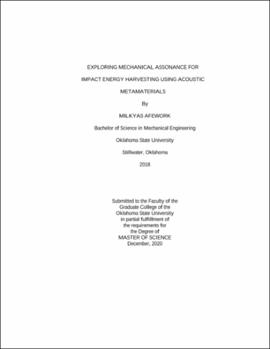| dc.contributor.advisor | Manimala, James M. | |
| dc.contributor.author | Afework, Milkyas | |
| dc.date.accessioned | 2021-08-03T18:53:41Z | |
| dc.date.available | 2021-08-03T18:53:41Z | |
| dc.date.issued | 2020-12 | |
| dc.identifier.uri | https://hdl.handle.net/11244/330186 | |
| dc.description.abstract | Acoustic metamaterials are engineered to possess unique dynamic properties that are not commonly found in nature. It has been demonstrated that customizing the characteristics of their local features can help optimize their dynamic performance under specific loading conditions. Drawing inspiration from the literary device called 'assonance,' the term 'mechanical assonance' may be ascribed to the dynamic phenomenon realized by sequencing oscillators with tuned responses within a waveguide to engineer a prescribed wave transformation across it. In this context, assonance provides a framework to utilize resonant local features within a host structure or material and interactive mechanisms thereof as building blocks to create enriched functionalities for acoustic metamaterials. Using a discrete element representation for an acoustic metamaterial barrier (AMB), a numerical case study is conducted to ascertain parametric dependence for assonant mechanisms related to resonator frequencies, their sequencing, and host material stiffness. Normalized metrics are extracted to estimate transmitted pulse mitigation under impact-type loading. It is found that resonator sets with octave spacing having the number of resonators of a specific frequency proportional to that frequency's amplitude in the input spectrum is desirable for lower transmissibility. Further, sequencing the lowest frequency resonator set closest to the incident-side gives better performance. Engineering a high degree of impedance mismatch between host material sections is also preferable. The energy sequestered by the local resonators is amenable to harvesting by utilizing the resonator's mass as the multifunctional kernel for a linear electromagnetic generator. A multiphysical model is developed to predict the harvested electric voltage and power from the AMB and validated using proof-of-concept experiments. Finally, various coil placement and voltage rectification schemes are also studied using simulations to ascertain preferable design configurations | |
| dc.format | application/pdf | |
| dc.language | en_US | |
| dc.rights | Copyright is held by the author who has granted the Oklahoma State University Library the non-exclusive right to share this material in its institutional repository. Contact Digital Library Services at lib-dls@okstate.edu or 405-744-9161 for the permission policy on the use, reproduction or distribution of this material. | |
| dc.title | Exploring mechanical assonance for impact energy harvesting using acoustic metamaterials | |
| dc.contributor.committeeMember | Bai, He | |
| dc.contributor.committeeMember | Wang, Shuodao | |
| osu.filename | Afework_okstate_0664M_16944.pdf | |
| osu.accesstype | Open Access | |
| dc.type.genre | Thesis | |
| dc.type.material | Text | |
| dc.subject.keywords | acoustic metamaterials | |
| dc.subject.keywords | energy harvesting | |
| dc.subject.keywords | impact mitigation | |
| dc.subject.keywords | mechanical assonance | |
| dc.subject.keywords | shock absorption | |
| dc.subject.keywords | vibration isolation | |
| thesis.degree.discipline | Mechanical and Aerospace Engineering | |
| thesis.degree.grantor | Oklahoma State University | |
